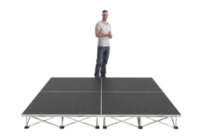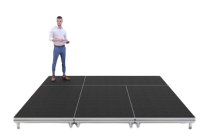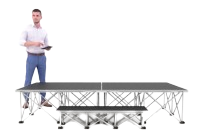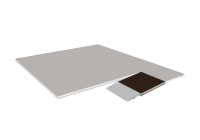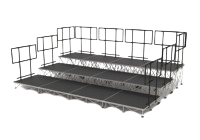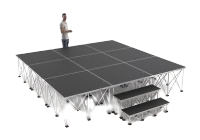Stage Platforms
Reliable Stage Platforms sit at the heart of every successful production, presentation, or public gathering. Whether a stage for a small school hall or a staging for theatre, the raised surface on which performers stand needs to remain secure, quiet, and adaptable. Choosing an appropriate system involves balancing weight tolerance, ease of movement, and venue layout, while never losing sight of safety regulations.
Core Characteristics of Contemporary Staging Platforms
Modern staging platforms tend to follow a few common design principles yet leave ample room for customisation. Instead of the heavy wooden structures once carried by endless crew members, present-day units often combine reinforced steel frames with lightweight composite staging tops. The result is a product capable of heavy load bearing without being a burden to manoeuvre.
- Load Capacity – High footfall and heavy props demand generous static and dynamic load ratings.
- Quiet Construction – Rattle-free connections keep microphones from picking up unwanted noise.
- Surface Options – Textured coatings, carpet, or hardwood veneers allow an aesthetic that matches the venue.
- Intuitive Locking Systems – Quick-fit clamps or cam locks simplify assembly while ensuring rigidity.
Where Platform Stage Systems Excel
The humble platform stage proves its worth across multiple sectors. Community centres create pop-up performance spaces in minutes; conference organisers lift keynote speakers above floor level for improved sightlines; schools shift from assemblies to concerts without calling in outside contractors. In each scenario, the same fundamental requirement applies: a solid, level deck that installs fast and stores small.
Typical scenarios include:
- Drama and musical theatre where interchangeable set pieces demand frequent re-configurations
- Corporate environments needing a defined focal area for speakers and panel discussions
- Educational settings shifting timetables between lectures, band practice, and awards evenings
- Pop-up festivals where efficient truck-to-stage transitions keep schedules on track
Portable Stage Platform – Mobility Without Compromise
Venues working to tight turnaround times gravitate toward the portable stage platform. Sections usually fold or feature detachable legs, allowing a single trolley to carry multiple decks through narrow doorways. Despite the convenient size, structural integrity remains paramount; therefore, reputable manufacturers test components to professional loading standards.
Advantages of adopting a portable stage platform:
- Rapid deployment by two people or fewer
- Compact footprint inside backstage cages or storage cupboards
- Integrated linking brackets that prevent lateral movement
- Choice of heights to suit both seated and standing audiences
Raised Stage Platform – Maximising Visibility
A raised stage platform boosts the relationship between performer and audience. By lifting talent above eye level, sightline issues disappear and crowd engagement rises. To achieve this, manufacturers reinforce vertical supports with cross-bracing, while anti-slip feet protect polished timber or sports-hall floors.
Key considerations when selecting a raised unit:
- Overall height relative to the back row of seating
- Local regulations regarding guard rails beyond specific elevations
- Cable routing channels for lighting or audio feeds
- Acoustic dampening materials to reduce footfall resonance
Collapsible Stage Platform – Space-Saving Genius
Some venues face a daily battle with storage cupboards bursting at the seams. Enter the collapsible stage platform. Hinged frames fold down to a fraction of their operating size, meaning even modest equipment rooms can house an entire performance deck. Quick-release catches eliminate the need for tools; therefore, caretakers and volunteers appreciate the straightforward workflow.
Typical benefits include:
- Flat-pack profile that slides into narrow rack bays
- Weight-optimised sections achievable by a single handler
- Repetitive open/close cycles tested far beyond normal usage
- Compatibility with add-ons such as step units or fibreglass skirts
Design Decisions That Influence Long-Term Success
Every site presents different logistical challenges. A touring theatre company may prioritise speed, while a civic auditorium focuses on acoustic neutrality. The following checkpoints aid specifiers in narrowing down suitable Stage Platforms:
- Frequency of Use – Daily setups place higher demands on connection hardware than annual showcases.
- Transportation Routes – Door widths and lift capacities dictate maximum deck dimensions and weight.
- Storage Availability – Foldable or nesting frames prove invaluable where floorspace is at a premium.
- Event Type – Loud rock concerts require more robust vibration control than spoken-word readings.
- Finish & Branding – Veneers or printed facings align the visual identity of the venue or sponsor.
Health & Safety: A Non-Negotiable Element
Professional venues rarely cut corners on safety, and staging platforms form no exception. Manufacturing standards such as BS EN 13814 or equivalent region-specific benchmarks outline acceptable deflection rates and mechanical resistance. Routine inspections, documented maintenance, and competent operators all contribute to incident-free events.
Installation Guidance and Routine Maintenance
Even the most robust deck fails if poorly installed. Experienced crews adopt a checklist approach:
- Verify floor condition and gradient before laying out frames.
- Align sections loosely, engage locking devices, then apply final torque in a systematic pattern.
- Double-check leg inserts and braces for full engagement.
- After the event, clean surfaces with suitable detergents—abrasive pads shorten lifespan.
- Store panels vertically where possible to prevent warping.
Environmental Considerations
Sustainability enjoys a growing spotlight within live events. Manufacturers increasingly favour recyclable alloys or sustainably harvested hardwoods. Powder-coated finishes often replace solvent-based paints, reducing VOC emissions during production. Selecting equipment designed for refurbishment rather than single-use disposal further lowers a venue's carbon footprint.
Future-Proofing Staging Solutions
Entertainment technology evolves rapidly; augmented reality backdrops, automated scenery, and intelligent lighting all place fresh demands on flooring. Selecting staging platforms capable of supporting cable troughs or secondary load-bearing rails keeps venues ready for forthcoming innovations without structural overhauls. Forward planning, therefore, means fewer hidden costs.
In Summary
From lightweight portable stage platform kits to large-scale raised stage platform installations, the modern performance deck must combine strength, agility, and minimal footprint. Venues that weigh load ratings, assembly methods, and long-term maintenance at the purchasing stage secure a reliable foundation for countless events.


